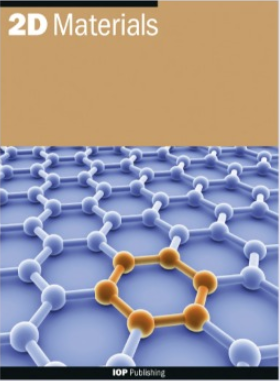Flux-pinning mediated superconducting diode effect in NbSe2/CrGeTe3 heterostructure
IF 4.3
3区 材料科学
Q2 MATERIALS SCIENCE, MULTIDISCIPLINARY
引用次数: 0
Abstract
In ferromagnet/superconductor bilayer systems, dipolar fields from the ferromagnet can create asymmetric energy barriers for the formation and dynamics of vortices through flux pinning. Conversely, the flux emanating from vortices can pin the domain walls of the ferromagnet, thereby creating asymmetric critical currents. Here, we report the observation of a superconducting diode effect (SDE) in a NbSe2/CrGeTe3 van der Waals heterostructure in which the magnetic domains of CrGeTe3 control the Abrikosov vortex dynamics in NbSe2. In addition to extrinsic vortex pinning mechanisms at the edges of NbSe2, flux-pinning-induced bulk pinning of vortices can alter the critical current. This asymmetry can thus be explained by considering the combined effect of this bulk pinning mechanism along with the vortex tilting induced by the Lorentz force from the transport current in the NbSe2/CrGeTe3 heterostructure. We also provide evidence of critical current modulation by flux pinning depending on the history of the field setting procedure. Our results suggest a method of controlling the efficiency of the SDE in magnetically coupled van der Waals superconductors, where dipolar fields generated by the magnetic layer can be used to modulate the dynamics of the superconducting vortices in the superconductors.NbSe2/CrGeTe3 异质结构中由磁通钉介导的超导二极管效应
在铁磁体/超导体双层系统中,来自铁磁体的双极性场可通过磁通钉化作用为涡旋的形成和动力学创造非对称能量障碍。反之,涡旋产生的磁通量可以钉住铁磁体的畴壁,从而产生非对称临界电流。在这里,我们报告了在 NbSe2/CrGeTe3 范德华异质结构中观察到的超导二极管效应(SDE),其中 CrGeTe3 的磁畴控制了 NbSe2 中的阿布里科索夫涡旋动力学。除了 NbSe2 边缘的外在涡旋钉扎机制外,磁通钉扎引起的涡旋体钉扎也会改变临界电流。因此,这种不对称现象可以通过考虑这种体销机制与 NbSe2/CrGeTe3 异质结构中传输电流的洛伦兹力引起的涡旋倾斜的综合效应来解释。我们还提供了通量针化临界电流调制的证据,这取决于场设置程序的历史。我们的研究结果提出了一种在磁耦合范德华超导体中控制 SDE 效率的方法,其中磁层产生的偶极场可用于调节超导体中超导涡旋的动态。
本文章由计算机程序翻译,如有差异,请以英文原文为准。
求助全文
约1分钟内获得全文
求助全文
来源期刊

2D Materials
MATERIALS SCIENCE, MULTIDISCIPLINARY-
CiteScore
10.70
自引率
5.50%
发文量
138
审稿时长
1.5 months
期刊介绍:
2D Materials is a multidisciplinary, electronic-only journal devoted to publishing fundamental and applied research of the highest quality and impact covering all aspects of graphene and related two-dimensional materials.
 求助内容:
求助内容: 应助结果提醒方式:
应助结果提醒方式:


